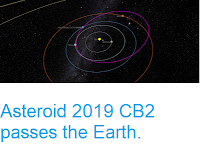Asteroid 2019 DB passed by the Earth at a distance of about 980 800
km (2.56 times the average distance between the Earth and the Moon, or
0.66% of the distance between the Earth and the Sun), slightly before 6.10 pm
GMT on Sunday 24 February 2019. There was no danger of
the asteroid hitting us, though were it to do so it would not have
presented a significant threat. 2019 DB has an estimated
equivalent
diameter of 11-34 m (i.e. it is estimated that a spherical object
with
the same volume would be 11-34 m in diameter), and an object of this
size
would be expected to explode in
an airburst (an explosion caused by superheating from friction with the
Earth's atmosphere, which is greater than that caused by simply
falling, due to the orbital momentum of the asteroid) in the atmosphere
between 30 and 15 km above the ground, with only fragmentary material
reaching the Earth's surface.
The calculated orbit of 2019 DB. JPL Small Body Database.
2019 DB was discovered on 26 February 2018 (two days after its closest approach to the Earth) by the Zwicky Transient Facility at Palomar Observatory in California. The designation 2019 DB
implies that the asteroid was the second object (object B -
in numbering asteroids the letters A-Z, excluding I, are assigned
numbers from 1 to 25, so that B = 2) discovered in the second half of February 2019 (period 2019 D).
2019 DB has a 572 day orbital period and an eccentric orbit
tilted at an angle of 9.08° to the plane of the Solar System, which
takes it from 0.97 AU from the Sun (i.e. 97% of the the average distance
at
which the Earth orbits the Sun) to 1.72 AU from the Sun (i.e. 172% of
the
average distance at which the Earth orbits the Sun, and outside the orbit of the planet Mars). It is therefore
classed as an
Apollo Group Asteroid (an asteroid that is on average further from the
Sun than the Earth, but which does get closer). This means that close
encounters between the asteroid and Earth are common, with the
last having occurred in March 2008 and the next predicted
in January 2020.







